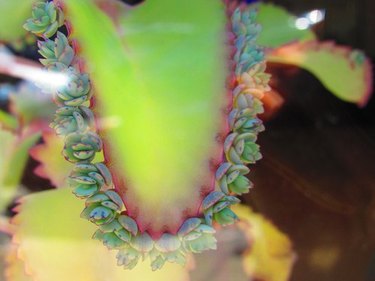
Are succulents the rock stars of the plant world? It hard to argue with that sentiment. Their wild variety of shape, size, and color is enough to warm any plant lover's heart; plus, all succulents have those thick leaves that store water and make them so easy to care for.
Once you have succulents, it's guaranteed that you'll want more to add to your collection or give them as gifts to your friends. You are in luck because succulents are easy to propagate from cuttings, which means you can make more plants without spending any money.
Video of the Day
Video of the Day
Welcome to the World of Succulents
Succulents are popular houseplants; think jade plants, donkey's tails, aloe vera, snake plants, mother of thousands, Christmas cacti, hens and chickens, and string of pearls. They also make terrific landscape plants in the warmer hardiness zones.
The adjective "succulent" means juicy, and succulents deliver with their thick, fleshy, water-storing leaves and/or stems. They are forgiving plants that thrive on neglect, and they're drought-tolerant. Many of them grow amazing and unexpected flowers in brilliant shades, and all make happy, low-care companions. Yet another aspect of the charm of succulents is that they are super easy to propagate!

Propagating Succulents
Ready to grow your succulent family? That's what propagating succulents is all about, and most succulents you buy come into the world this way. By rooting leaves or stems from your current plants, you can grow additional plants. The procedure is easy, and yes, you can do it with the clippings from annual pruning.
You will read online that the best time to propagate succulents is during the growing season, and this may be true. But I've "made" new succulents all year long by rooting plant pieces in a sunny window.
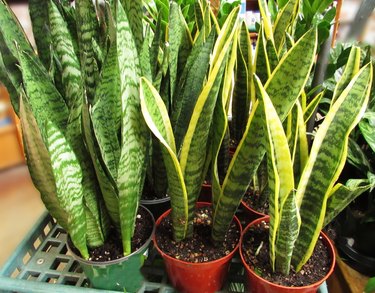
Getting Started With Rooting
Keep in mind that this is a no-stress exercise that's great for kids and beginners as well as experienced gardeners. You don't need to worry about getting cuttings that are a perfect length, and the process itself offers many options. You can often root either the leaf or the stem of the plant. You can root it in water or soil, and in some species, you can simply transplant an offshoot for an immediate plant.
Tip
While you can propagate succulent cuttings in water, you are more likely to succeed with soil. It's just a lot easier for cuttings to rot in water.
Some succulents are easier to propagate than others. If you have several choices, go for a jade plant (Crassula ovata), a slow-growing succulent that looks like a little tree. Stonecrops (Sedum spp.) like donkey's tail are also on the easy-peasy list, and echeveria (Echeveria spp.) is also a good choice for beginners. Any of these succulent varieties can be propagated by leaf or stem.
How to Root a Stem or Leaf in Soil
Your basic choices for rooting succulents are rooting soil or water. Although the latter option allows you to watch those roots grow, I always opt for rooting in soil since it's so easy and successful — and it is awkward to stand up a leaf in water.
Things You'll Need
Parent plant
Garden scissors or pruner
Succulent potting soil
Shallow container
Water
1. Take cuttings
Stem cuttings: Select a parent plant that is healthy and happy. Use garden scissors or pruners to cut a stem at least 4 inches long. The stem must be long enough that it will stand upright in the soil, holding up leaves or rosettes. Make a clean cut, taking care not to damage the stem.
Leaf cuttings: Use care when removing a leaf since you need to be sure to get the base of the leaf as well. This section is what connects the leaf to the stem, and it is from here that roots will grow. Just pull gently, twisting it a little, and the base will come off as well.
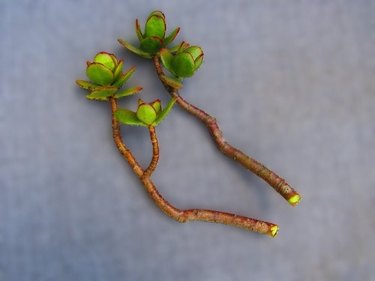
2. Allow the cut stem or leaf to dry out
Remember that succulents are succulent! You want that juicy stem to dry out and callous over before putting it in the ground. Learn from my mistake! I got so excited that I just popped the plant stems in the soil. Some did just fine, but others rotted.
Save yourself time and effort by allowing the succulent stems or intact leaves to sit in a dry, warm area for several days. The cut sections will callous over.
3. Pot up the cuttings
Fill a shallow container with moistened, well-draining potting soil; specialty succulent potting soil is ideal. The container doesn't need to be more than 4 to 6 inches deep since the succulent roots will be relatively close to the surface.
Install the cuttings so that the cut section touches the soil. For stem cuttings, stand up the cutting by poking the calloused end in the soil. For leaf cuttings, lay the leaves on top of the soil with the base of the leaves facing the soil.

4. Move it to a bright site
Sit the container on a windowsill or outdoors if the weather is warm. The cuttings can dry out from direct light, so pick a spot with indirect or dappled sunlight.
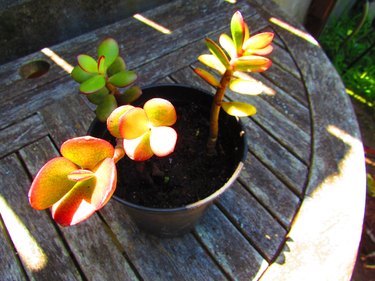
5. Watch for roots
Don't water the cuttings until you see the beginning of roots on the plants. These will look like tiny white nubs growing from the calloused area. It will likely be about four weeks before these start appearing. At that point, place water directly on each root area. Don't water again until the soil is dry. It may be several months before the roots are sufficiently established.
6. Repot the new succulents
When the root systems are established, your cuttings are ready to face the world as stand-alone plants. Use a small container for each cutting. Fill it with the same well-draining potting soil that you used for rooting and put it in bright, indirect sunlight. Water sparingly and watch it grow.
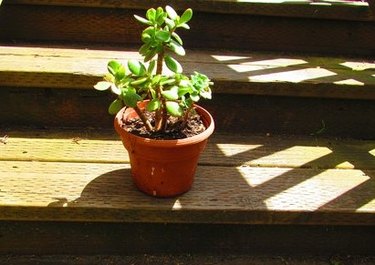
How to Root a Stem in Water
Soil propagation for succulents is the better way to go, but I admit that there is an appeal in putting the stem cuttings in water and actually seeing the roots appear. Give it a try if you'd like.
You start the same way as for soil propagation, taking cuttings from a healthy parent plant and allowing them to dry out. Then, remove the lower leaves from the stems and pop them in a clear glass of water. Remove it and plant in soil after the roots appear.

Propagating Succulents From Offsets
Some succulents grow offsets, aka pups or chicks. These are tiny plants that grow beside the parent or sometimes on its leaves. They are clones of the parent plant and can be removed and grown separately.
Which succulents produce offsets? Many do, including hens and chicks (the poster child of succulents with chicks), echeveria, aloe vera, and mother of thousands.
To obtain a new plant from an offset, you must carefully remove the baby plant and repot it in a new container with well-draining potting soil. Don't worry that the parent plant will suffer. Rather, removing pups gives the parent plant more energy for its own growth.
